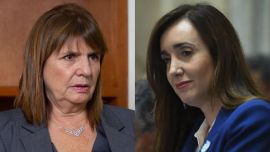Does it make sense to enter into a tough sovereign debt restructuring negotiation with the wolves of Wall Street in the midst of the global coronavirus pandemic?
The Covid-19 outbreak has wrecked havoc throughout financial markets, causing a devastating blow to asset prices, as the lagged effects of countrywide lockdowns and social distancing seeps through the “real” economy. Paradoxically, IMF chief Kristalina Georgiva says, “we anticipate the worst economic fallout since the Great Depression.” Encouraging stuff from the people running the institution that is expected to act as the global firefighter while the house is burning.
In that context, Economy Minister Martín Guzmán, flanked by, among others, Vice-President Cristina Fernández de Kirchner, laid out the basic plan for his offer to private creditors, indicating they hadn’t reached an agreement in previous conversations and that this was a final offer. He also gave a 20-day negotiating window. To the already unlikely prospect of a quick resolution, Guzmán raised the bar further. Adding one more obstacle, Argentina has a US$500-million payment coming up on April 22 to bondholders, which, if missed, triggers a 30- day period until a credit event or default occurs. Tick-tock.
Whether or not he is ultimately successful, Guzmán didn’t really have a choice but to present his offer as soon as possible. The financial and economic collapse that has engulfed the globe has only accelerated Argentina’s march toward the limits of its financing capacity. The national quarantine announced by President Alberto Fernández has forced 54 percent of small- and medium-sized companies to halt operations, genera- ting a daily cost of some US$115 million and putting nearly half a million jobs at risk, according to Fundación Observatorio Pyme. Thee shutdown of the country’s borders, coupled with an international move toward limiting the flow of goods and people, has severely reduced commerce, making it all the more difficult for the Argentine economy to produce dollars. Commodity prices have tanked on the back of a massive demand shock, meaning the agricultural sector and the promising Vaca Muer a shale formation will suffer greatly. Brazil, our major trading partner, is second only to the United States in the Americas in confirmed cases and deaths, and its curves show acceleration similar to Italy and Spain, epidemiologist Roberto Chuit of the Argentine Institute of Epidemiological Investigations said. According to the Institute of International Finance, Latin America will see output fall 4.5 percent this year, “a contraction much larger and more widespread than during the GFC [Global Financial Crisis].”Argentina’s GDP could fall anywhere from 5 to 10 percent according to recent estimates.
ON BOTH SIDES OF THE AISLE
President Alberto set the scene: he invited governors from both sides of the aisle, Mrs. Fernández de Kirchner, and Sergio Massa, the speaker of the Chamber of Deputies. Guzmán delivered what he was brought from Columbia University to do, announcing his intention to stop payments until the end of 2023, a 62 percent haircut on coupon payments and a 5.4 percent shave to the capital payments. More than US$40 billion in debt relief, which could pay for nearly three million respirators through 2025 or a full year of national pension and retirement payments. “Today, and for several years, Argentina can’t pay anything,” he said, adding, “there’s people playing hardball, creditors that want Argentina to pay more and many interests at play.” Cristina sat quietly. A proud Alberto took the floor, dubbing the situation he inherited a “virtual de- fault” while “assuming an obligation with the financial system that does not presuppose a postponement of Argentines who are in a tough spot, they are our priority.”
The fine details of the report were presented to the US Securities and Exchange Commission late yesterday. Ten new bonds in US dollars and Euros that will begin to pay 0.5 percent annual interest starting November 15, 2023 were unveiled, with a gradual increase in coupon payments to 4.75 per- cent on the longest-maturity paper.
There are no win-win situations when it comes to a sovereign debt restructuring. The sovereign is already walking into the room wounded, crushed by a mountain of debt and an inevitable economic crisis. Creditors know they need to concede, giving up future profits or entering into decades-long litigation that is costly and unwanted (unless you are Paul Singer). Guzmán’s proposal is in line with what his mentor, Joseph Stiglitz, recently wrote in an article where he called for global debt relief to avoid a wave of defaults. Argentina’s offer to bondholders asks for a grace period to generate the conditions for economic growth that will allow the nation to destine some of its extremely limited resources to paying its debt starting at 0.5 percent interest rate and gradually making its way to 4.5 percent, putting the average interest rate at 2.33 percent.
It sounds like a decent deal for Argentina, even if it’s impossible to put together sound economic projections in the midst of the global coronavirus pandemic. It could end up being insufficient, and it depends on a successful renegotiation with the IMF to structure a new programme under Argentina’s terms. Yet, those sitting on the opposite side of the negotiating table feel it’s too good for Argentina. According to initial reports major bondholders BlackRock, Greylock, Pimco, and Fidelity had previously rejected Guzmán’s offer. They don’t believe President Fernández wants a disorderly default and understand the “final offer” as a formal first step in the negotiations, yet they’re very far from what’s been proposed. Also, what is Argentina’s economic plan, they ask? How will the country reverse systematic deficits, inflation, economic stagnation? How would the nation had done it before the Covid-19 outbreak that put the world on its knees was already a major question, which becomes all the more relevant when fiscal stimulus and further monetary easing are needed to avert a Depression scenario. Already we’ve seen a 175 percent increase in the fiscal deficit in real terms in March on the back of increased social spending, while tax revenues slid 14.7 percent year-over-year.
For investors, it’s a mathematical question. They are calculating the exit yield and the net present value of the securities they are holding in order to figure out how much they will lose in order to figure out the best deal in a cost-benefit scenario. For Argentina, this is an existential manner, as the beleaguered nation seeks to avoid its ninth sovereign debt default and another “lost decade”, or half-century. The “corona-crisis” doesn’t make it any easier. Lucky for us, we’re used to crises in Argentina.























Comments